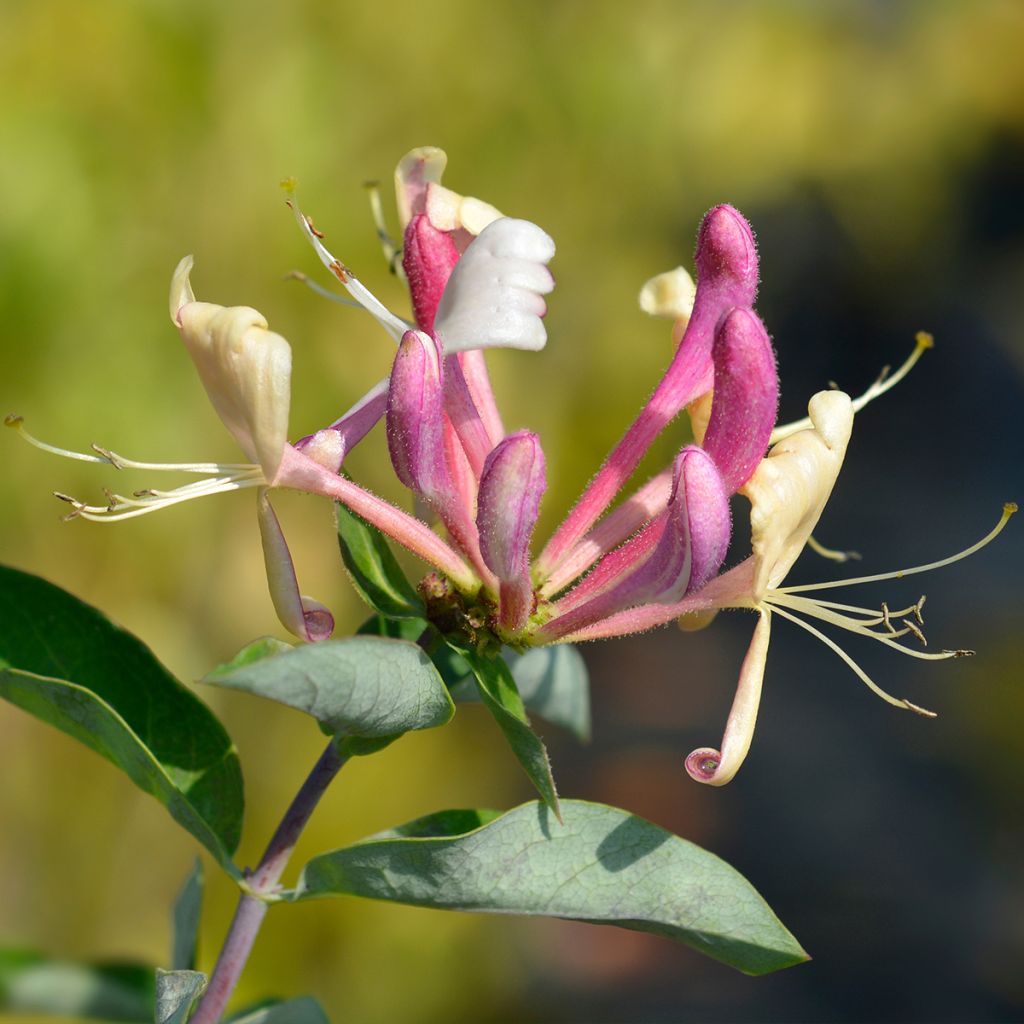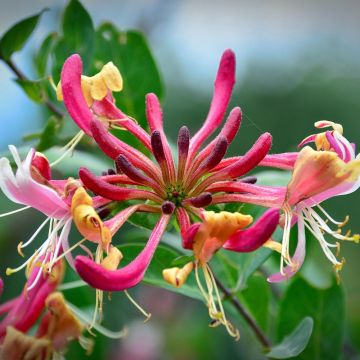

Lonicera periclymenum Belgica


Lonicera periclymenum Belgica
Lonicera periclymenum Belgica
Lonicera periclymenum Belgica
European honeysuckle, Woodbine, Eglantine, Wild Honeysuckle
This honeysuckle was a good size... But just like the lemon tree, the foliage was pressed tightly against the trunk and seemed wilted... but since this was a gift, it didn't look very nice.... disappointed about that.
Marie, 09/06/2025
Special offer!
Receive a €20 voucher for any order over €90 (excluding delivery costs, credit notes, and plastic-free options)!
1- Add your favorite plants to your cart.
2- Once you have reached €90, confirm your order (you can even choose the delivery date!).
3- As soon as your order is shipped, you will receive an email containing your voucher code, valid for 3 months (90 days).
Your voucher is unique and can only be used once, for any order with a minimum value of €20, excluding delivery costs.
Can be combined with other current offers, non-divisible and non-refundable.
Home or relay delivery (depending on size and destination)
Schedule delivery date,
and select date in basket
This plant carries a 6 months recovery warranty
More information
We guarantee the quality of our plants for a full growing cycle, and will replace at our expense any plant that fails to recover under normal climatic and planting conditions.
Would this plant suit my garden?
Set up your Plantfit profile →
Description
Lonicera periclymenum 'Belgica' is a variety of woodbine honeysuckle that has many advantages. With fast growth, it is an excellent climber for quickly covering a trellis. Throughout the summer, it produces aesthetically pleasing tricoloured flowers, white, yellow, and red, that are pleasantly fragrant. These are followed by small, highly decorative bright red berries. Hardy and easy to cultivate, this plant prefers humus-rich, well-drained soils that are somewhat moist, and can grow in both full sun and partial shade.
Lonicera periclymenum belongs to the Caprifoliaceae family, which blesses us with so many essential ornamental genera (Abelia, Kolkwitzia, Weigela, Viburnum, Symphoricarpos...) as well as lesser-known but equally interesting ones (Heptacodium or Dipelta, for example...). Lonicera periclymenum is our woodbine honeysuckle, whose natural distribution area covers all of Western Europe, from Spain to southern Scandinavia, demonstrating its great adaptability. In the wild, it develops strong voluble stems of 3 metres (10 feet) or more that spontaneously wind around neighbuoring shrubs and trees. This wild honeysuckle has given rise to numerous cultivars with flowers of different colours.
The 'Belgica' honeysuckle is close to the species type, from which it has retained its vigour, as it grows rapidly to reach heights of up to 5 metres (16 feet) or more, with a width of about 3 metres (10 feet). Its robust stems bear elliptical leaves, medium green and glaucous on the underside, which persist to a greater or lesser extent during mild winters. The leaves are arranged in pairs, on either side of the stem. In June, coloured floral buds (red-purple) appear, which then give way to tubular flowers from August to September. These flowers form at the tips of the shoots from the current year, and are gathered in generous, powerfully fragrant clusters that perfume the entire summer. Highly visited by pollinating insects, they are followed by the formation of highly decorative bright red berries, about 5 mm (0.2in) in diameter. These fruits are highly appreciated by birds, but be careful, as they are slightly toxic to humans.
This honeysuckle grows in neutral or slightly acidic soil, disliking limestone. It prefers humus-rich, fairly rich and fresh soils, even moist, especially if planted in full sun. In partial shade, it will be more tolerant of soil humidity, tolerating dry periods once well-rooted. Nevertheless, it is always preferable to water it occasionally in summer to promote its flowering. Hardy, -20°C (-4°F) approximately, this climber is easy to cultivate, requiring only a little pruning after flowering to limit its growth and rejuvenate its shoots.
'Belgica' will be superb trained against a wall, on a trellis or fence, on an arch or pergola, preferably near the patio, the entrance of the house, or a door to fully enjoy its fragrance, which is particularly heady in the evening. Alternatively, it can also make good groundcover in a wild corner of the garden. You can associate it with other vigorous climbers to cover a large area, and by choosing staggered flowering, you can enjoy them for a good part of the year. An excellent choice in this regard would be to adopt Clematis 'Mayleen', a superb variety with fragrant pink flowers in May, which will precede this honeysuckle. In a not too harsh climate, Passiflora caerulea will enchant you from late summer until October with its sculptural flowers, unlike any other.
Report an error about the product description
Lonicera periclymenum Belgica in pictures


Plant habit
Flowering
Foliage
Safety measures
Botanical data
Lonicera
periclymenum
Belgica
Caprifoliaceae
European honeysuckle, Woodbine, Eglantine, Wild Honeysuckle
Cultivar or hybrid
ingestion
Cette plante est toxique si elle est ingérée volontairement ou involontairement.
Ne la plantez pas là où de jeunes enfants peuvent évoluer, et lavez-vous les mains après l'avoir manipulée.
Pensez à conserver l'étiquette de la plante, à la photographier ou à noter son nom, afin de faciliter le travail des professionnels de santé.
Davantage d'informations sur https://plantes-risque.info
Other Honeysuckle
View all →Planting and care
Like all honeysuckles, 'Belgica' thrives in soil that is no more than slightly chalky, even tolerating some acidity. It prefers rich and humus-rich soils, that are moist and well-drained. In partial shade, it will tolerate drier conditions more easily, but if you plant it in full sun and your soil is very well-drained (sandy or sandy loam type), you will need to enrich it to make it more water-retentive. In this case, dig a hole of 50 to 60 cm (20 to 24in) on each side and mix with the existing soil some planting compost and humus at a ratio of one third each, then water abundantly. Soak the root ball in a bucket of water for 15 minutes to moisten it well before planting, fill the hole and water again.
Monitor watering during the first two years, especially in summer, and water regularly to promote root growth. Guide the young shoots onto the chosen support in the first year, they will then attach themselves. Prune back excessively long shoots after flowering by cutting just above a vigorous shoot.
Like all honeysuckles, it is susceptible to powdery mildew in summer, when conditions are hot and dry. To avoid powdery mildew, plant in moist, not too dry soil, avoid exposure to the scorching midday sun and ensure that air circulates within the foliage by thinning out excess shoots, not pressing the shoots against a wall, but keeping the support at least 5-10 cm (2-4in) away from the wall. If necessary, in case of severe attack, consider treating with sulphur.
Planting period
Intended location
Care
-
, onOrder confirmed
Reply from on Promesse de fleurs
Similar products
Haven't found what you were looking for?
Hardiness is the lowest winter temperature a plant can endure without suffering serious damage or even dying. However, hardiness is affected by location (a sheltered area, such as a patio), protection (winter cover) and soil type (hardiness is improved by well-drained soil).

Photo Sharing Terms & Conditions
In order to encourage gardeners to interact and share their experiences, Promesse de fleurs offers various media enabling content to be uploaded onto its Site - in particular via the ‘Photo sharing’ module.
The User agrees to refrain from:
- Posting any content that is illegal, prejudicial, insulting, racist, inciteful to hatred, revisionist, contrary to public decency, that infringes on privacy or on the privacy rights of third parties, in particular the publicity rights of persons and goods, intellectual property rights, or the right to privacy.
- Submitting content on behalf of a third party;
- Impersonate the identity of a third party and/or publish any personal information about a third party;
In general, the User undertakes to refrain from any unethical behaviour.
All Content (in particular text, comments, files, images, photos, videos, creative works, etc.), which may be subject to property or intellectual property rights, image or other private rights, shall remain the property of the User, subject to the limited rights granted by the terms of the licence granted by Promesse de fleurs as stated below. Users are at liberty to publish or not to publish such Content on the Site, notably via the ‘Photo Sharing’ facility, and accept that this Content shall be made public and freely accessible, notably on the Internet.
Users further acknowledge, undertake to have ,and guarantee that they hold all necessary rights and permissions to publish such material on the Site, in particular with regard to the legislation in force pertaining to any privacy, property, intellectual property, image, or contractual rights, or rights of any other nature. By publishing such Content on the Site, Users acknowledge accepting full liability as publishers of the Content within the meaning of the law, and grant Promesse de fleurs, free of charge, an inclusive, worldwide licence for the said Content for the entire duration of its publication, including all reproduction, representation, up/downloading, displaying, performing, transmission, and storage rights.
Users also grant permission for their name to be linked to the Content and accept that this link may not always be made available.
By engaging in posting material, Users consent to their Content becoming automatically accessible on the Internet, in particular on other sites and/or blogs and/or web pages of the Promesse de fleurs site, including in particular social pages and the Promesse de fleurs catalogue.
Users may secure the removal of entrusted content free of charge by issuing a simple request via our contact form.
The flowering period indicated on our website applies to countries and regions located in USDA zone 8 (France, the United Kingdom, Ireland, the Netherlands, etc.)
It will vary according to where you live:
- In zones 9 to 10 (Italy, Spain, Greece, etc.), flowering will occur about 2 to 4 weeks earlier.
- In zones 6 to 7 (Germany, Poland, Slovenia, and lower mountainous regions), flowering will be delayed by 2 to 3 weeks.
- In zone 5 (Central Europe, Scandinavia), blooming will be delayed by 3 to 5 weeks.
In temperate climates, pruning of spring-flowering shrubs (forsythia, spireas, etc.) should be done just after flowering.
Pruning of summer-flowering shrubs (Indian Lilac, Perovskia, etc.) can be done in winter or spring.
In cold regions as well as with frost-sensitive plants, avoid pruning too early when severe frosts may still occur.
The planting period indicated on our website applies to countries and regions located in USDA zone 8 (France, United Kingdom, Ireland, Netherlands).
It will vary according to where you live:
- In Mediterranean zones (Marseille, Madrid, Milan, etc.), autumn and winter are the best planting periods.
- In continental zones (Strasbourg, Munich, Vienna, etc.), delay planting by 2 to 3 weeks in spring and bring it forward by 2 to 4 weeks in autumn.
- In mountainous regions (the Alps, Pyrenees, Carpathians, etc.), it is best to plant in late spring (May-June) or late summer (August-September).
The harvesting period indicated on our website applies to countries and regions in USDA zone 8 (France, England, Ireland, the Netherlands).
In colder areas (Scandinavia, Poland, Austria...) fruit and vegetable harvests are likely to be delayed by 3-4 weeks.
In warmer areas (Italy, Spain, Greece, etc.), harvesting will probably take place earlier, depending on weather conditions.
The sowing periods indicated on our website apply to countries and regions within USDA Zone 8 (France, UK, Ireland, Netherlands).
In colder areas (Scandinavia, Poland, Austria...), delay any outdoor sowing by 3-4 weeks, or sow under glass.
In warmer climes (Italy, Spain, Greece, etc.), bring outdoor sowing forward by a few weeks.


















































